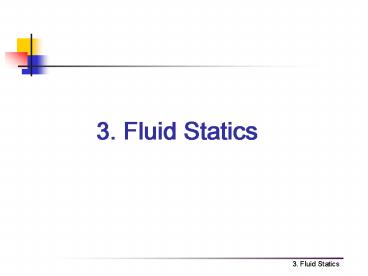3' Fluid Statics - PowerPoint PPT Presentation
1 / 29
Title:
3' Fluid Statics
Description:
3.2 Pressure at a Point : Pascal's Law. 3.3 Pressure ... 3.1 Definition of Fluids ... 3.8 Aerostatics. The temperature variation in the troposphere ... – PowerPoint PPT presentation
Number of Views:173
Avg rating:3.0/5.0
Title: 3' Fluid Statics
1
3. Fluid Statics
2
- 3.1 Definition of Fluids and Viscosity
- 3.2 Pressure at a Point Pascals Law
- 3.3 Pressure Distribution in a Static
- Fluid under Gravity
3
3.1 Definition of Fluids and Viscosity
- A fluid is a substance that deforms continuously
under the action of an applied shear forces,
or stress, of any magnitude.
? Fig. 3.1
4
- Q What is the difference between solid and
fluid?
- A For a constant shear force or shears the
deformation of solid, the shear angle, is
constant, but for the fluid the time rate of the
shear angle is constant. - solid fluid
5
- Consequence of the fluid deformation
- Fluid can be at rest, only when no shearing
stress acts. - Fluid can resist shear only when moving.
6
- What is viscosity?
Viscosity is a fluid property which indicates
how high is the deformation rate(shear rate),
of a fluid for a given shear stress,
For Newtonian fluids a linear relation
between and , ,
For non-Newtonian fluids non-linear,
7
? Fig. 3.2
? Fig. 3.3
8
3.2 Pressure at a PointPascals Law
- According to the deformation of fluids there are
no shear stresses acting on fluid elements at
rest. - Therefore, on the surfaces of a fluid element
at rest of any shape only normal stresses can be
present. - The surface force from the normal stress on a
fluid element at rest under gravity must be in
equilibrium with the volume force of the fluid
element due to the gravity.
9
- From this equilibrium the Pascals law results
The pressure at any point in a fluid at rest
has a single value, independent of direction.
- Pressure is a scalar quantity
10
? Fig. 3.4
The equation of motion in the y and z direction
are,
From geometry,
11
The equation of motion can be rewritten as
We take the limit as and approach zero
- The pressure at a point in a fluid at rest, or
in motion, is independent of direction as long as
there are no shearing stresses present. Pascals
Law
12
3.3 Pressure Distribution in a Static
Fluid under Gravity
- If we let the pressure at the center of the
element be designated as p, then the average
pressure on the various forces can be expressed
as Fig. 3.5.We are using a Taylor series
expansion of the pressure at the element center.
or
? Fig. 3.5
13
The resultant surface force acting on the element
can be expressed in vector form as
or
(3.1)
The group on terms in parentheses in Eq. 3.1
represent in vector form the pressure gradient
where
The symbol is the gradient or del vector
operator. Thus,
Since the z axis is vertical, the weight of
element is
Newtons second law, applied to the fluid
element, can be expressed
or
(3.2)
Therefore,
14
- Incompressible Fluid
Changes in are caused either by a change
in or . For most engineering applications
the variation in is negligible, so our main
concern is with the possible variation in the
fluid density. For liquids the variation in
density usually negligible so that the assumption
of constant specific weight when dealing with
liquids is good one.
(3.3)
or
Where p1 and p2 are pressure at the vertical
elevations z1 and z2, as is illustrated in Fig.
3.5. Eq. 3.3 can be rewritten as
(3.4)
(3.5)
or
15
? Fig. 3.6
16
3.4 Applications
- 3.4.1 Communicating Tube
? Fig. 3.7
17
3.4.2 Pascals Paradox
? Fig. 3.8
18
3.4.3 Hydraulic Jack
(3.6)
? Fig. 3.9
19
3.4.4 Manometer
- A) U-Tube Manometer
(3.7)
(3.8)
(3.9)
? Fig. 3.10
20
- B) Prandtl-Manometer
(3.10)
(3.11)
? Fig. 3.11
21
- C) Betz-Manometer
? Fig. 3.12
22
- D) Manometer for Small Pressure Difference
? Fig. 3.13
23
3.4.5 Hydraulic Siphon
(3.16)
? Fig. 3.14
24
3.4.6 Chimney
? Fig. 3.15
25
3.5 Hydrostatic Force on a Plane Surface
? Fig. 3.16
? Fig. 3.17
26
- The magnitude of the resultant force can be
found by summing these differential forces
over entire surface.
(3.17)
The integral is the first moment of the area with
respect to the x axis
(3.18)
or
- The moment of the resultant force must equal the
moment of the distributed pressure force, or
Therefore,
The integral is the second moment of the area
with respect to axis formed by the intersection
of the plane surface and the free surface.
By parallel axis theorem
(3.19)
Thus,
27
3.6 Buoyancy Archimedes Principle
(3.20)
(3.21)
(3.22)
? Fig. 3.18
28
3.7 Hydrostatic Force
on a Curved Surface
(3.23)
(3.24)
? Fig. 3.19
29
3.8 Aerostatics
(3.25)
The temperature variation in the troposphere
(3.26)
Eq.3.27 ? Eq.3.26 and integrating,
(3.27)
(3.28)
(Pc at the lower edge of the stratosphere Zc)
? Fig. 3.20





















![L 13 Fluids [2]: Statics ? fluids at rest PowerPoint PPT Presentation](https://s3.amazonaws.com/images.powershow.com/7504382.th0.jpg?_=20160101045)









